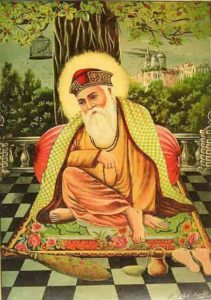
The origins of Sikhism are in the teachings of Guru Nanak and his successors. Nanak disapproved of many religious beliefs and practices of his time. The essence of Sikh teaching is summed up in these words: “Realisation of Truth is higher than all else. Higher still is truthful living”.
Sikhism believes in equality of all humans and rejects discrimination on the basis of caste, creed, and sex. Sikhism also does not attach any importance to asceticism as a means to attain salvation, but stresses on the need of leading life as a householder.
Sikhism is a monotheistic religion. In Sikhism, God-termed Vāhigurū-is shapeless, timeless, and sightless. The beginning of the first composition of Sikh scripture is the figure “1”- signifying the universality of God. Sikhs believe that before creation, all that existed was God and hukam (will or order). When God willed, the entire cosmos was formed. From these beginnings, God nurtured “enticement and attachment” to māyā, the human perception of reality.
Pursuing Salvation and Khalsa
Nanak’s teachings are founded not on a destination of heaven or hell, but upon a spiritual union with God which results in salvation. The chief obstacles to the attainment of salvation are social conflicts and an also attachment to worldly pursuits, which commit men and women to an endless cycle of birth – a concept which is known as reincarnation.
Māyā, defined as illusion or “unreality”, is one of the core deviations of the pursuit of God and salvation: people are distracted from devotion by worldly attractions that give us only illusive satisfaction. However, Nanak emphasised māyā as not a reference for the unreality of the world, but of the world’s values. In Sikhism, the influences of ego, anger, greed, attachment, and lust, known as the Five Evils, are believed to be especially pernicious. The fate of people vulnerable to the Five Evils is separation from God, and the situation is remedied only after intensive and relentless devotion.
The Ten Gurus and Religious Authority
The term guru comes from the Sanskrit gurū, which means teacher, guide, or mentor. All the traditions and philosophy of Sikhism were established by ten specific gurus from 1499 to 1708. Each guru reinforced and added to the message taught by the previous, resulting in the creation of the Sikh religion. Nanak was the first guru and appointed a disciple as his successor. Gobind Singh was the final guru that is in human form. Before his death, Gobind Singh decreed that the Gurū Granth Sāhib would be the final and perpetual guru for the Sikhs. The Sikhs believe Nanak’s spirit was passed from one guru to the next, ” just as the light of one lamp, which lights another and does not diminish “, and is also mentioned throughout their holy book.
After Nanak’s passing, the most important phase in the development of Sikhism occured with the third successor, Amar Das. Nanak’s teachings emphasised pursuit of salvation; Amar Das began building a cohesive community of followers having initiatives such as sanctioning distinctive ceremonies for birth, marriage, and death. Amar Das also established the manji (comparable to a diocese) system of clerical supervision.
Observances
Observant Sikhs follow long-standing practices and traditions to strengthen and express their faith. The daily recitation from memory of certain passages from the Gurū Granth Sāhib, especially the Japu (or Japjī, literally chant) hymns is recommended immediately after rising and bathing. Family customs include both reading passages from the scripture and also attending the gurdwara (also gurduārā, meaning the doorway to God; sometimes transliterated as gurudwara). Sikhs commonly enter the temple, touch the ground before the holy scripture with their foreheads, then make an offering.
Ceremonies and Customs
Nanak taught that rituals, religious ceremonies, and idol worship are of little use and they are discouraged from fasting or going on pilgrimages. But during the period of the later gurus,
and owing to an increase in institutionalization of the religion, some ceremonies and rites did arise. Sikhism is not a proselyting religion and most Sikhs generally do not make active attempts to gain converts. However, converts to Sikhism are all welcomed, although there is no formal conversion ceremony. Morning and evening prayers take around two hours a day, starting in the very early morning hours. The first prayer in the morning is Guru Nanak’s Jap Ji. Jap, meaning “recitation”, refers to the using sound, as the best way to approach the divine. Like combing hair, hearing and reciting the sacred word is used as a way to comb all of one’s negative thoughts out of the mind. The morning prayer in the morning is Guru Gobind Singh’s universal Jaap Sahib. The Guru addresses God to have no form, no country, and no religion but as the seed of seeds, sun of suns, and the song of songs.
Baptism and the Khalsa
Khalsa (meaning pure) is the name given by Gobind Singh to Sikhs who have been baptised or initiated by taking ammrit in a ceremony that is called ammrit sañcār. The first time this ceremony took place was on Vaisakhi, which fell on 29 March 1698/1699 at Anandpur Sahib in Punjab. It was during that occasion that Gobind Singh baptised the Pañj Piārē who in turn baptised Gobind Singh himself.
Baptised Sikhs are bound to wear the Five Ks (in Punjabi known as pañj kakkē or pañj kakār), or articles of faith, at all times. The tenth guru, Gobind Singh, ordered these Five Ks to be worn so that a Sikh could actively use them to make a difference to their own and to others’ spirituality. The 5 items are: kēs (uncut hair), kaṅghā (small comb), kaṛā (circular iron bracelet), kirpān (dagger), and kacchā(special undergarment). The Five Ks have both practical and symbolic purposes.
